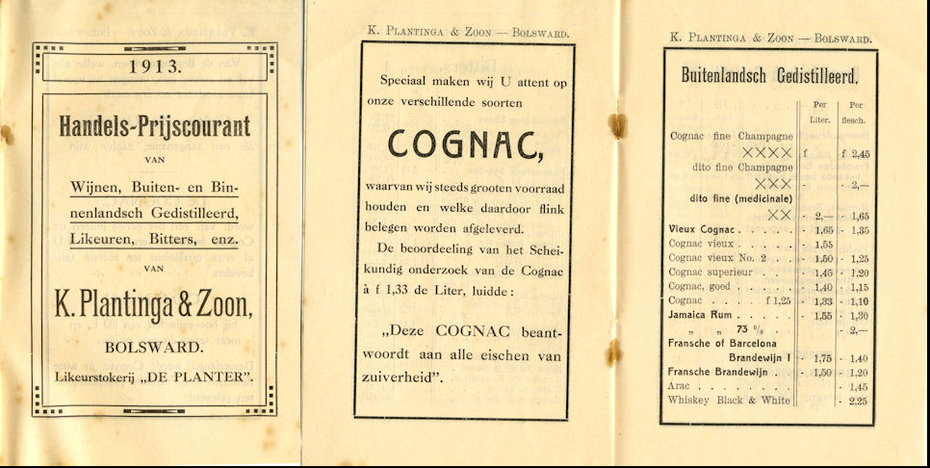
Planti(nga) (Cogn)ac
Plantiac (called Plantinga Cognac until the early 1960s) is a type of Dutch brandy (in Dutch: Vieux). This is Dutch imitation Cognac (a type of brandy), previously also called (in Dutch) "Koetsiertje" or "Koetsierscognac" (as in Cognac drunk by carriage riders - Dutch "koetsiers") or "Hollandse Cognac" ("Dutch Cognac"). The reason for the invention of this product was the first world war, which resulted in the supply of French Cognac drying up. Cognac is a grape-based distilled product, whereas Dutch Brandy has virtually nothing to do with grapes.
Any Dutch Brandy is supposed to consist of at least 35% of alcohol, and may not contain more than 20 grammes of sugar per litre. Often a little real Cognac, eau-de-vie or other grape-based distilled product is added. The brown colour of Vieux can be obtained using caramel or an artificial colouring.
In 2009, Vieux was the fifth most popular alcoholic beverage in the Netherlands by consumption percentage (after Jonge Jenever, Whisky, Liqueur and rum) at 5,9% (coincidentally, at a par with Beerenburg).
Plantiac has a warm, dark-ish brown colour. The beverage is based on molasses-alcohol, with added essences and extracts to produce its characteristic taste. The aromas used in the production of Plantiac are purchased from Quest International and IFF. The exact ingredients are kept secret - they are what make each Vieux unique. However, the essences and extracts used for Plantiac include fusel oil, amyl alcohols, vanilla, esters, prune extract and the concentrated liquids (Dutch "Blokdrop") that can be obtained from the roots of the liquorice plant (Glycyrrhiza glabra, Dutch "zoethoutwortel"). No so-called eau-de-vie (or a any other grape-based product) is used. It contains 35% of alcohol. The brown colour of Plantiac is obtained using caramel.
It is not certain when Plantiac was first made. The early little "Prijscourant" (price list) booklets the company released several times per year do not mention "Plantinga cognac" nor "Plantiac", rather "Cognac" or "Cognac Vieux" ("Vieux" is, basically, French for "old") listed under "Foreign liquor". It is unclear whether they made that themselves (in which case it could have been some sort of Plantiac, but false advertising to boot) or (most likely) imported it. The Plantinga company seems to have concentrated on importing cognac at least until 1936.
Although 1970 advertisements insist on a 100-year anniversary at that time, this is almost certainly not true. Plantiac was first produced as Plantinga Cognac by the Plantinga distillery in Bolsward, Friesland province, the Netherlands, most likely in the 1930s or 1940s. The 100-year anniversary in 1970 seems to refer, rather, to the Plantinga company as a whole. "Plantinga's Cognac" is first documented in a "Prijscourant" published on 1 January 1940.
Whereas the Treaty of Versailles (1919) already forbade use of the name “Cognac” from being used for products produced outside of the French Cognac region, Dutch Brandy (including Plantinga Cognac) was sold under the Cognac name until the 1960s. The packaging (including stars) was clearly derived from Cognac packaging.
More pressure from the French government led to a law that then definitely no longer allowed for the name “Cognac” to be used. It was ratified by the Dutch Supreme Court in a Trade Treaty with France on 1 June 1956.
Dutch Brandy producers decided upon the name “Vieux”, which had already been used before - it is French for “old” and was often used to describe Old Dutch Brandy (“Cognac Vieux”) – and which did not provide any pronunciation difficulties. Around that time, Gerrit Herman Plantinga (born 1929, son of Louwrens Baltus Plantinga (1902-1993), who was son of Gerrit Herman Plantinga (1876-1962), who was in turn son of Klaas Plantinga, founder of the Plantinga distillery) thought up the Plantiac name. He and some of his colleagues working at Natlab constructed it from the family name ("Planti-") and the name 'cognac' ("-ac"). The Plantiac name was first seen used in a 1961 advertisement, although that year also saw advertisements still using the name "Plantinga's Cognac Vieux". Plantiac became an official registered trademark on 8 April 1971.
Until 1972, Plantiac (and before that, Plantinga Cognac) was produced in Bolsward. From 1972 to 2004, it was produced by the UTO company (since 2011 renamed to Herman Jansen) in Schiedam, also in the Netherlands. There, it was bottled about once per month. Since July 2004, Plantiac has been produced under exclusive licence from the Herman Jansen company by Boomsma in Leeuwarden, Friesland province, the Netherlands. In 2013, it was stated that Plantiac was bottled 5 to 8 times per year, 5000 to 10000 bottles each time, only in 1 litre bottles.
In 2009, Dutch brandy was the fourth most popular drink in the Netherlands (after Young Gin, Whisky, Liquer and Rum) with a market share of 5,9% (at the same spot as Beerenburg, incidentally). In 2011 it was found at the seventh spot (now after Beerenburgh and Vodka) with a market share of 5,4%. A total of 34.500 hectolitres are produced annually (source: spirits.nl).